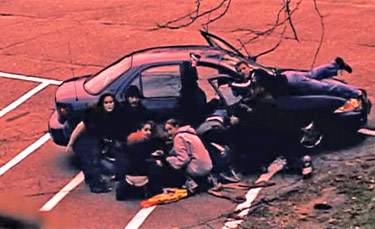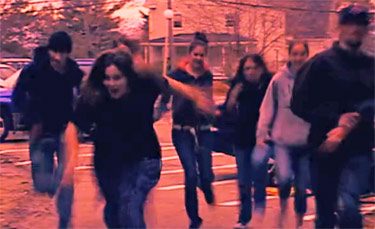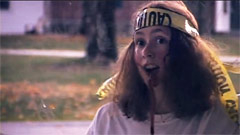HvZ: It's Not Just a Game
By Eric Boyer
It was a cold and drizzling Tuesday night, but this did not deter the small group of humans that had hunkered down in a makeshift structure. They spoke with a mix of bravado and tension, confident in their ability to hold off the zombie hoard that was gathering in the distance. They had already survived for the entire week, and now simply had to survive one more challenge.
The survivors' strategy seemed solid, and they only had to protect the crude beacon for 30 minutes. The zombie hoard had other plans.
Three whistle blasts pierced the stillness, and the hoard attacked en masse. The hoard, approximately 50 strong, quickly dismantled the structure protecting the humans, and within seconds the zombies declared victory.
Though it had all the tension and suspense of a George Romero film, this scene took place on a soggy November evening in Mercer Field. These zombies, and the humans attempting to escape them, were all students playing the game Humans vs. Zombies. To understand why students could be found huddled on Mercer Field on such an evening, it is first necessary to understand the ground from which this game arose.
In the fall of 2009, a student in my Pathway class named John Clarke asked me to serve as faculty advisor for a new “capture the flag” club. I agreed, but our planning quickly became much more ambitious, thanks to an e-mail sent to me by Associate Dean of Students Robin Davis. The e-mail contained a link to an NPR account of Goucher College's “Humans vs. Zombies” game, and I was instantly hooked. Why bring students out for a one-night game of capture the flag, when we could have them running scared for an entire week?

Humans vs. Zombies is essentially a week-long game of tag. All players begin the game as humans, with a strip of cloth tied around their arm or leg to show they are playing. One or two unmarked “alpha zombies” exist on the campus, and it is these original zombies (played last spring by President Galligan and this fall by Professors Donna Berghorn and Kathleen Farrell) who begin tagging players. When a player is tagged, they move their strip of cloth to their head and become a zombie who must go out to tag other humans. Humans can defend themselves by stunning a zombie with a Nerf gun or throwing a balled-up sock, which freezes the zombie for 15 minutes and allows for escape.
Why do students play? The answer is easy. The students who play are among the many who have watched a zombie film and had two simultaneous thoughts: 1) If I were in this movie, I would survive and 2) If I were a zombie in this movie, there is no way the humans would survive.
The game took place outdoors (not inside any buildings at all), and only on the Colby-Sawyer campus, but it was quite a harrowing (and community-building) experience for all involved. By the last day of both games, approximately 10 remaining humans were facing an army of zombies that out-numbered them 5 to 1. These few survivors have been telling (and retelling) their stories of near escapes, desperate rescue attempts and elaborate strategies. Just getting to the dining hall for a warm meal became an epic struggle for survival.

While no humans survived the fall semester, the small group of spring survivors were honored with the Zombie Cup, an impressive trophy created by ceramics student Chelsea Sumersall. The Zombie Cup, along with the pictures of survivors from the spring semester, will be on display in the College Archives.
Overall, the event was an incredible success here at Colby-Sawyer. In both the spring and fall games, over 15 percent of the student body took part, with Alumni Relations, Admissions, the college radio station, the Courier, the college archivist, Safe Zones, and even President Galligan getting into the fun in one way or another. As faculty advisor, it gave me great joy to see how this event kept students on-campus and outside over a beautiful fall weekend, with old cohorts dissolving and new ones forming as the number of humans dwindled.
While it is a constant struggle to make sure the game does not disrupt the college's academic mission, or pull in non-players, the spring and fall experiences have already become part of Colby-Sawyer legend. Just ask any of those who survived the now-famous “Battle of Ware Hall” in the spring of 2010, or any of the unfortunates who did not manage to guard that beacon on Mercer Field...
Eric Boyer, assistant professor of Social Sciences and Education, serves as faculty advisor to the Humans vs. Zombies events at Colby-Sawyer College. Joe Delaney '11, a Communication Studies major, created the video trailer for the HvZ game. The photos above are still shots extracted from his video.
Editor's Note: The short story "The Couple Voted Most Likely to Stay Together" by Colby-Sawyer's Director of International Student Services and adjunct faculty member in the Humanities Department David Elliott is included in the Granite State zombie anthology, "Live Free or Undead." Find out more here.



